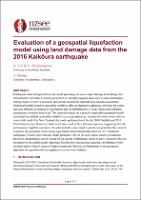Evaluation of a geospatial liquefaction model using land damage data from the 2016 Kaikoura earthquake

Download
Date
2021-04-14Authors
Lin, Amelia
Wotherspoon, Liam
Motha, Jason
Metadata
Show full item recordAbstract
Earthquake induced liquefaction and lateral spreading can cause major damage to buildings and infrastructure networks. Common procedures to identify exposed areas such as cone penetration testing require extensive resources and are not suitable for national scale hazard assessments. Statistical models based on geospatial variables offer an alternative approach, allowing for a time and cost efficient estimation of liquefaction and the identification of areas where more detailed assessments would be beneficial. The research focuses on a globally applicable geospatial model developed on publicly accessible variables such as precipitation, distance to closest water body or water table depth. For New Zealand, the model performed well for the 2010 Darfield and 2011 Christchurch event. However, both events were used in the calibration process, suggesting that the performance might be overstated. In order to better understand its prediction potential, the research evaluates the geospatial model using liquefaction observational data from the 2016 Kaikōura earthquake. Results show that the model performs well for the observation cluster in Kaikōura. However, discrepancies can be found for the cluster in Blenheim, which is partly caused by the low resolution of the global model input data. Despite the contradicting outcome, the findings of this research help to identify areas of improvement and illustrate the limitations of the geospatial approach for regional and local application across New Zealand.
